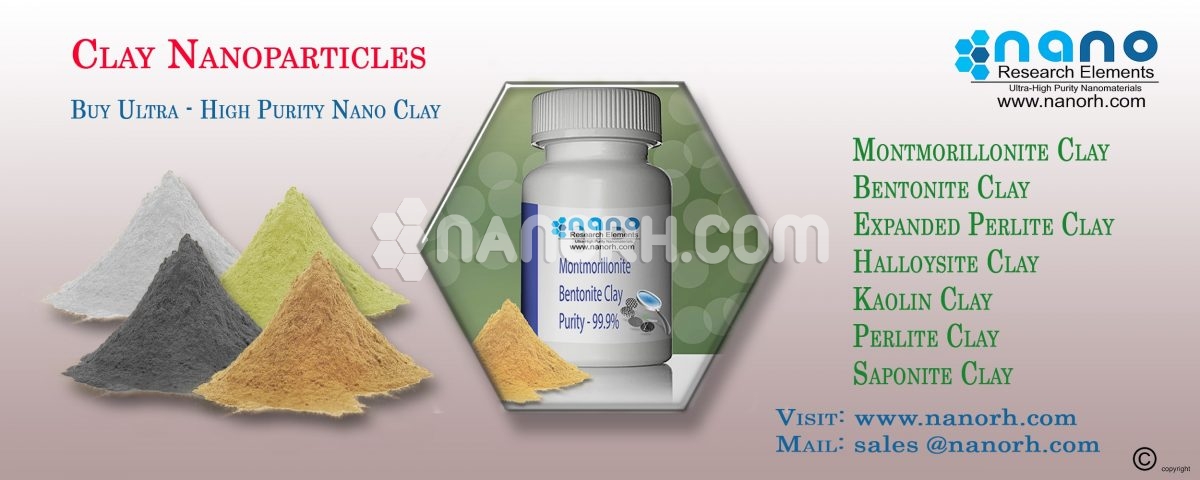NANOCLAYS
NANOCLAYS
INTRODUCTION
Nanoclays are nanoparticles of layered mineral silicates. Contingent upon synthetic structure and nanoparticles morphology, nanoclays are sorted out into a few classes, for example, montmorillonite, bentonite, kaolinite, hectorite, and halloysite.
Nanoclays are a kind of layered silicates with nonmetric thickness and distance across of 50– 200 nm. These nanoplates have numerous applications, for example, antibacterial movement, sanitizing impact, adsorption of poisons, and film covering. The consolidation of nanoclays into polymeric grids could upgrade the mechanical, physical, and obstruction properties of polymers. Montmorillonite (MMT), kaolinite, and saponite are precedents of nanoclays that have been utilized as fillers in the sustenance frameworks. MMT has pulled in extraordinary enthusiasm for the sustenance business because of their cost adequacy, the accessibility, straightforward process capacity, and noteworthy change in execution. They are layered silicates containing two composed tetrahedral silicon molecules, which combined to edge-shared octahedral sheet of for the most part aluminum or magnesium oxide.
Characteristic MMTs have hydrophilic properties because of the nearness of inorganic cations on their surface and in this manner in mix with hydrophobic polymers are insufficient. A few adjustments have been utilized for development of nanoclays properties. Naturally altered nanoclays, for example, Cloisite 30B and Cloisite 20A have expanded interlayer dispersing, hydrophobic surface, and better collaborations with natural polymers. Likewise, these nanoclays have antimicrobial movement against both Gram-positive and Gram-negative microscopic organisms. Antimicrobial impact could be because of quaternary ammonium gathering of naturally altered nanoclays that interface with bacterial cell and upsets their phone layers lastly causes cell lysis.
Notwithstanding immediate antimicrobial impacts of nanoclays, they have additionally backhanded antimicrobial impacts in mix of polymers. For instance, in CS nanoclays nanocomposites, nanoclays could adsorb microbes from an answer and prompt better association of microscopic organisms with antimicrobial polymer. In a few investigations it is demonstrated that nanoclays in blend with polymer frameworks could control dispersion of antimicrobial mixes. In dynamic bundling it is essential to control the arrival of bioactive operator so that accomplished the base inhibitory fixation for the objective microorganism and kept up as far as might be feasible in nourishment items.
NANOCLAYS AS NANO FILLERS FOR POLYMER-CLAY NANOCOMPOSITES
Nanocomposites are a genuinely new class of composite materials where filler having something like one measurement in the nanometer (10−9 m) go is scattered in a persistent lattice. They got acknowledgment after the main fruitful improvement of Nylon nanocomposites having upgraded mechanical properties by the Toyota analysts. From that point forward, nanocomposites have been significant territory of research.
The nanocomposites have indicated enhanced mechanical and warm properties; diminished combustibility and boundary properties than both miniaturized scale and large scale composite materials. The filler stacking; their shape, angle proportion and their partiality towards network material are among unmistakable parameters that assume a fundamental job in adjusting the properties. The nanocomposites could be set up by various strategies incorporating into situ polymerization, liquefy intercalation and direct blending. The scattered filler can be of the state of circle, tube, fiber or lamellae. The relationship of properties of materials with filler measure has picked up a lot of significance with the ongoing progression in the field of nanotechnology.
Attributable to their uncommon potential to show exceptional qualities that couldn't have been accomplished with their customary smaller scale partners, they have pulled in a lot important to display improved and novel properties. There have been contemplates on the joining of nanoparticles having contrasts fit as a fiddle, estimate, perspective proportion, structure and geometry; and a few nanoparticles have been perceived as conceivable added substances to improve execution properties.
Nanoclays are inflexible fillers and change in the moduli of lattice material with the joining of these Nanoclays is by and large credited to their high solidness. Polymeric frameworks are delicate materials and their support with unbending nanoclays block the free development of polymer fastens neighboring to the filler and if the interfacial grip.

